Feature Story
The Motorcycle Cop of Bergen Belsen - A Jewish Civil Policeman's Story in The Liberated Concentration Camp Of Bergen Belsen, 1945 – 1950; Part 2
There were more than 12,000 resident witnesses over a 5 year period living at the largest Jewish DP Camp in Germany.
There were many history books and eye witness accounts that were published without even a mention.
This is a story that not even the Bergen Belsen Document Center had documents nor pictures of (until now)....
And Heebs on Hogs™ is proud to be able to tell the story!
© Heebs on Hogs™ 2019 – 2020 (Spring - Summer 2020)
by Michael Edelstein, Publisher
In Part One of our interview, we found out how Mr. Lou from Sighet, Romania was deported by the Nazis as a teenager, working his way through 8 different Concentration and Work Camps. He was finally liberated during a 188 km - 117 mile death march in Germany from Oranienburg to Schwerin by the Americans. Eventually, he found his way from an American “recuperation” Camp for Displaced Persons (DPs) in Lubeck, found his sisters at the Bergen Belsen DP Camp, returned to his home town in Sighet, Romania where the Communist Soviet Russians had taken over, and then went to Western Europe to escape the Communists before they closed the Romanian border. Mr. Lou found his way back to the Bergen Belsen DP Camp, where a friend got him a position driving and maintaining the Camp motor pool, even though Mr. Lou didn’t know how drive nor fix any vehicle.
Developing the Bergen Belsen DP Camp into a Full Functioning Jewish Mini-City
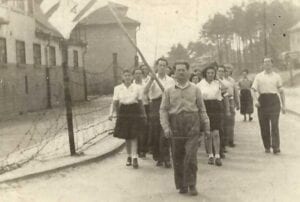
One of the Zionist Jewish Youth Groups going on an outing.
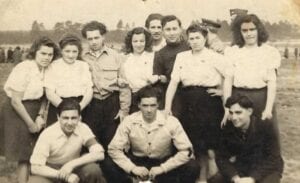
Many friendships were made at Belsen. Mr. Lou is third from the left standing.
When the British military converted the German military base located 1.2 miles from the Bergen Belsen Concentration Camp into a DP Camp for refugees in 1945, they named the DP Camp “Hohne” after a nearby abandoned settlement in order to avoid the association with Nazi genocide at the Bergen Belsen Concentration Camp. However, the Jewish residents refused to accept the British name Hohne and continued to call the DP Camp Bergen Belsen, or just either Bergen or Belsen. With an initial Jewish population of about 9,000 Jewish refugees and its peak at about 12,000, Bergen Belsen was a “mini city” which gradually had a full range of facilities for its residents. The camp had political representatives, a 200 bed hospital, a movie theater, an amateur orchestra, small manufacturing facilities, a printing press, a newspaper called "Unser Shtimme" (Our Voice) and all types of schools including a nursery, kindergarten, an elementary school, two Beth Jacob (Beis Yaakov) Girls Schools (Polish and Hungarian), a Yeshiva (school of advanced Jewish studies), a High School, vocational schools run by the Organization for Rehabilitation Training (known by its acronym, ORT), several youth movements and three Halutz youth organization houses. Children were also provided with a variety of extracurricular activities. The Camp also had an orthodox Rabbinical Court (Beis Din) and offices representing some international Jewish organizations such as the Joint Distribution Committee (AJCD) and ORT. The first wedding at Belsen took place in June, 1945. Many followed after that with lots of newborn babies. While married couples lived together, single men and women lived separately in the Camp and there was a Camp curfew at 20:00 (8 o'clock in the evening). There were regular social and cultural activities throughout the camp, including sports teams (and a boxing team!), various youth group activities and Saturday night dances featuring visiting bands playing the Big Band sounds of the 1930s and 1940s. German citizens, unless permission was granted, were not allowed in the camp.
The camp was under British authority and in March, 1946, they transferred the administration of the camp to the United Nations Relief and Rehabilitation Administration (UNRRA), and then to the International Relief Organization (IRO) which provided for the basic needs of the camp. The Jewish DPs had religious and political autonomy to determine their own destiny without too much interference from the British.
Creating the Jewish Civil Police
The political organization which the Jews had created before arriving in the DP Camp in 1945 was known as the Central Jewish Committee. With the facilities and population of this “mini city” growing, there had to be some type of policing structure to maintain order. One of the major British complaints was about the illegal sales of goods, especially cigarettes which were always at a premium. These illegal sales were referred as the Black Market and it existed throughout Germany and Europe. The Black Market was also strong inside of the Belsen Camp, and was additionally a source that to many nearby German towns.
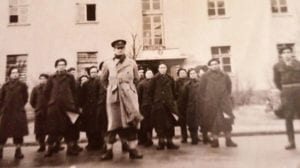
The tall British soldier in the white military coat was David Kalnitsky, known fondly by many as "The Captain". Here he is during a formation with some of the members of the Jewish Civil Police at the Bergen Belsen DP Camp.
The British agreed to a train a group of Jewish police to help keep law and order, and to stop the illegal sales and bartering within and outside of the Camp. They trained about 125 young Jewish men living inside the Camp as policemen and called them the Jewish Civil Police. There was some formal military discipline training prior to their appointments, yet, the Jewish Policemen were not allowed to carry any firearms (they didn’t even have hand cuffs), although some occasionally displayed rifles, but only during ceremonies.
The police powers of the Jewish Civil Police were limited, and the British were allowing the police to keep law and order up to a point while the British were still in control of the Camp. And even though the British might have had some faith that the Jewish Civil Police would keep some of the Black Market illegal activities under control, there is no doubt that many of the Jewish Civil Policeman were involved in some way with participating in some illegal activities in the Camp. There was no doubt that the policemen, including Mr. Lou, would later laugh about the illegal activities at Bergen throughout their lifetimes. And it didn’t involve anything as "minor" as the Black Marketing of cigarettes.
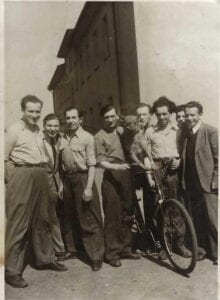
Once you've experienced a BMW R-75 with a side car, a bicycle, even with a dog on it, is just not the same! Mr. Lou is third from the right.
Before the British forces left Israel in 1948, the military wing of the Jewish Socialist Labor Party in British Palestine (also known as pre-1948 Israel) was the Haganah. The Haganah was the largest of the underground Jewish Military groups in British Palestine. With the knowledge of the opposition underground military groups located in British Palestine, specifically the Irgun and the Stern Group (Lehi), the Haganah secretly recruited residents who were living in Belsen, to help send “illegal” vehicles and equipment through the Camp. The Haganah was known to also secretly recruit members from various DP Camps in Europe who could help smuggle equipment and arms to them into Israel, as well as provide some formal training to the camp residents when they eventually would migrate to Israel. In Belsen there were several active Zionist youth groups representing various Zionist ideologies including the Haganah, however only the adults were recruited by the Haganah in the various Camps. It is unknown whether the British authorities knew that there was a secret group of Haganah affiliated military inductee members at the Belsen Camp, but Camp historians and former residents have mentioned their presence. The British administrators of the Camp, including some of the Jewish policemen of Belsen, reportedly never knew about many of these “illegal activities” going on at the DP Camp. And if they did, no one spoke about it. According to one source, the British Captain, David Kalnitsky had some unspecified ties to the Haganah which was only known by a very few people in the Camp.
There were “illegal” (stolen) vehicles that made their way into the Belsen Camp between 1946 through 1948, and were secretly shipped out to British Palestine. These vehicles came into the Belsen Camp and were then moved out and sent to help equip the Jews in Israel against the Arabs who were determined to murder every Jew in Israel before (and after) it officially would announce itself as an independent nation. The British were only allowing a very few, but not most of the DP residents from Belsen to legally migrate to British Palestine which caused major tension between the British and the residents of Belsen. Furthermore, at some point, the Belsen Camp was officially closed from accepting any more Jewish refugees as residents, however, there were estimates that probably more than a few thousand Jews from Europe were coming into Belsen “illegally” as a resting point before going on to “illegally” migrate to Israel. All these "illegal" activities and events were happening “under the noses” of the British.
Mr. Lou admitted that he knew about some of the vehicles that were sent to Israel through the camp, but claimed not to have been a secret member of the Haganah. He also said that he was not aware of any weapons that might have gone through the Belsen Camp.
The British finally left Israel on May 14, 1948, and the next day, Israel proclaimed it’s independence as a free country. After that time, the "illegal" activities of shipping equipment to Israel were at a minimum, however, the British spitefully would not allow the residents at the Bergen Belsen Camp free departure to leave the Camp to migrate to Israel until 1949. Most of the young residents of military age who went to Israel wound up joining the military and fighting in the Israeli-Arab War, and many of the former Jewish Civil Policemen of the Belsen Belsen DP Camp were killed in action.
Historical Background Information # 4
The Hanging that Broke the Will of the British Government and Ended the British Occupation of Israel
In December, 1917, during World War One, General Allenby and the British had conquered Israel from the Turkish military. The British and French defeated the Turks during the War and controlled the Middle East. They set up a joint "Occupied Enemy Territory Administration" in what had been the Ottoman Empire and the Middle East was split (partitioned) between France and the British with a pre-end of the War secret treaty known as the Sykes–Picot Agreement of 1916 (World War One ended on November 11, 1918). The British took control over Israel (and other countries) and achieved “legitimacy” for their continued control of the country by obtaining a Mandate from the League of Nations in June 1922. The formal objective of the League of Nations Mandate was for the British and French to administer different parts of the defunct Ottoman Empire, which had been in control of the Middle East since the 16th century. They were to provide administrative advice and assistance as a Mandatory "until such time as they (the countries they were Mandated to assist and protect) were able to stand alone (and develop into self-functioning governments)". (https://avalon.law.yale.edu/20th_century/leagcov.asp - See Article 22) The British became occupiers and clearly did not follow the rules nor the spirit of the Mandate. [also see Wikipedia on the Mandate https://en.wikipedia.org/wiki/Mandatory_Palestine#cite_note-4].
In British Palestine, the Jewish organization called the Haganah, was initially viewed by the British as an unarmed, quasi-police group which was part of the Labor Zionist movement headed by David Ben Gurion and Chaim Weitzmann of the Jewish Agency. Ben Gurion and Weitzmann for the most part cooperated with the British authorities, even to the extent where when they were asked to by the British Government, they willingly without objection gave up a major part (more than half) of the original land mandated to the Jewish People by the League of Nations (today, that part of land originally meant for the Jewish People became the country of Jordan). In reality, before 1948 the Labor Party and the Haganah, which advocated over many years for a negotiated settlement with the British to leave Israel (which was not successful), the Haganah was secretly arming themselves in anticipation of the day that the British were to leave Israel and they needed to defend themselves against the Arabs. There were also two main opposition military groups who did not accept the Haganah’s position of negotiation and “restraint” with the “British Occupiers”. They were adamantly in opposition to the Haganah’s tactics of negotiating with a country which had no intention of leaving Israel, and restricted the rights of the Jewish citizens living in the country. They made no secret of their military actions and worked hard to drive the British out of Israel through military harassment. These groups were the Irgun, which was led by the former Prime Minister of Israel, Menachim Begin (who served as Prime Minister from 1977 – 1983), and the smaller group, the Lehi, or Stern Group was led by the former Prime Minister of Israel, Yitzhak Shamir (who served from 1983-1984, and 1986 - 1992). The Irgun and the Stern Group were an offshoot of the Revisionist Zionist youth movement founded in 1923 in Riga, Latvia, by Vladimir (Ze'ev) Jabotinsky. They believed that when negotiations fail, military force is necessary. What Ben Gurion, Begin and Shamir all agreed upon was that eventually the British would leave the country and Israel would be left defenseless by the British occupiers without arms and equipment, which the British parenthetically provided to the Arab countries. Possession of a weapon in occupied British Palestine for a Jew could, and in some cases did, warrant a death sentence from the British Palestine courts. While Jews were killed in raids by the British, such as Abraham Stern who created the Stern Group, and was murdered on the spot by British soldiers as he surrendered, there were many Jews sentenced to hang throughout the years of the Mandate while others who were tried by the British court, were to serve life sentences with harsh labor. Of the last three Jews who were convicted to be hanged in 1947, one was charged for weapons possession and the other two were sentenced to hang for capturing a British officer and flogging him in retaliation for Jewish men who were convicted and flogged by the British. Most of the country was outraged that the death sentence was imposed, and all the appeals to stop the hangings were rejected by the British Court. In retaliation, the Irgun captured two British sergeants and threatened to hang them if the British Court was to carry out their unjust and overly cruel disproportionate sentence. The British knew the Irgun was good for their word and scoured the country, arrested many and enforced curfews all in order to find the sergeants, but without any success. The British Court, without backing down to the Jewish communities pleas throughout the world, defiantly proceeded to hang these three young Jewish men.
On July 29, 1947, the Irgun hanged the two British Sergeants in retaliation for the hanging of three Irgun members by the British. Even though there was a very strong world condemnation against the Irgun which included many anti-Semitic reactions, and additional outrage from Ben Gurion and the Labor Party, the British stopped hanging Jews in Israel. These were to be the last executions of young Jewish men in a series of hangings performed by the British. According to Colonel Archer Cust, who had been Chief Assistant to the Chief Secretary of Palestine, the Irgun broke the will of the British People to stay in Israel and on May 14, 1948, the British withdrew their forces. The Mandate was finally over.
Mr. Lou was the main driver at the Camp. There were two people in charge of the Jewish Police, Simcha Vinik and David Kalnitsky. Kalnitsky was a tall, well dressed British officer and the men referred to him affectionately as “The Captain”. One of Mr. Lou’s responsibilities included driving a car to pick up Kalnitsky in the morning at his residence in the Camp and bringing him to his office. Many times The Captain would offer Mr. Lou a "spot of tea" before leaving.
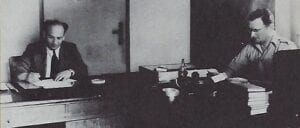
Simcha Vinik, on the left, and David Kalnitsky on the right, are at their desks. Both shared the responsibilities of the Jewish Civil Policemen.
Mr. Lou would also occasionally drive some of the official visitors to the Camp such as the British "War Hero" Field Marshall Bernard Law Montgomery, nicknamed “Monty” as well as other ranking visitors. There was a hospital at Belsen, however if anything happened that required more complex hospital equipment that was not available at the Camp, Mr. Lou would drive people to the main hospital which was located in the Port City of Hamburg, some 102 km (63 miles) away. From a historical perspective, Mr. Lou saw two things that he remembered well during his time at Belsen. During one trip to Hamburg in 1947, Mr. Lou saw one of the most famous “illegal” ships which was initially attempting to transport Jews to break the British Palestine blockade. Unfortunately, it had been "caught" by the British and was being jammed up and held in the Hamburg port by the British military. It had many Belsen residents on board, and the ship was the famous “Exodus” which was the subject of many books and a movie. The other historical event which Mr. Lou (and many DPs at the Camp) would see on a regular basis occurred in 1948 - 1949. That was the famous Berlin Airlift where American and British airplanes flew into Berlin to drop off food and supplies to the German people who were trapped by a Soviet Communist blockade. The blockade was carried out for the political purpose of starving the people living in West Berlin. The Allies flew mostly into the Tempelhof Airport located in West Berlin from June 24, 1948, through May 12, 1949, and when the Soviets did not see success with the efforts of their nearly one year political and economic ploy, they stopped the blockade. (for more information, see: https://history.state.gov/milestones/1945-1952/berlin-airlift).
There were two official Camp Police motorcycles located at the Belsen Camp, one was a small motorcycle and the other was a captured German BMW R-75 motorcycle with side car. Even though he drove the various Camp vehicles, while on police patrol, the BMW became Mr. Lou’s primary and favorite vehicle.
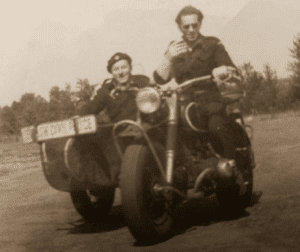
Mr. Lou with Monyok Hochman in the side car.
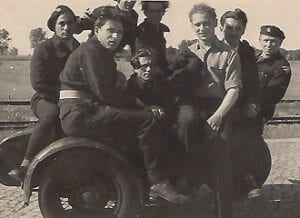
Just a group of Policemen hanging around with Mr. Lou (standing in the middle back) and figuring out how many Policemen can fit onto a BMW R-75....
Mr. Lou had no previous driving skills yet taught himself how to drive and to at least superficially fix a car, jeep, truck, ambulance and motorcycle which were part of the motor pool at Belsen. Among some of the vehicles in the motor pool, the Camp had a Ford Ambulance, which was a 1941 American Chevy “Woody” station wagon, a Dodge 6 wheeler vehicle and a jeep. There were other vehicles owned by UNRRA and the IRO, as well as military vehicles which would occasionally arrive for a temporary stay at the Camp. And of course, there was the Camp’s two motorcycles. Coincidentally, one of the friend’s Mr. Lou would make at the Camp was also a policeman and drove some vehicles in the motor pool. His name was Moshe Monyok Hochman, a cousin to a woman, Regina, that Mr. Lou would eventually meet in America and marry some 7 years later. Moshe would occasionally drive the Camp jeep and would sometimes ride in the side car of the BMW R-75 motorcycle when Mr. Lou was driving. The BMW acquired its own “celebrity” status at the Camp, and Mr. Lou guarded it and treated it with as much love as any motorcycle enthusiast would have. Almost every Jewish survivor at the Camp had at some time seen German military motorcycles with side cars during the War, and not under positive conditions. Mr. Lou was able to create an image of a user friendly, former German military motorcycle which now became a familiar and popular sight throughout the Camp, driven by the friendly and popular policeman, Mr. Lou.
Mr. Lou would patrol the area of the camp with his BMW R-75 many times with Monyok Hochman riding in the sidecar. Sometimes Mr. Lou would ride so fast (he was only a young guy barely in his 20’s) that when he would turn corners, occasionally his sidecar would slightly rise up off the ground into the air to the naturally expected fear of his side car companion. Moshe, many times would inevitably scream and beg Mr. Lou to please slow down.
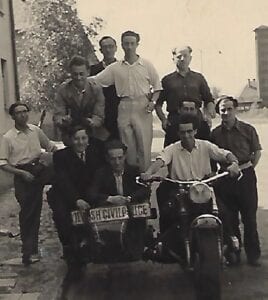
Mr. Lou in the drivers' seat and his friends hanging out together around the camp's BMW R-75 motorcycle.
In spite of his new found love of motorcycles and the occasional terror he would instill in Moshe, Mr. Lou was a careful driver and only had one accident which destroyed his small motorcycle and left him confined to a hospital bed. For the first time in his life, Mr. Lou attended a party and drank a little more alcohol than he was able to handle. That evening when he left a party, he drove his small motorcycle back to the motor pool. On his way, he made a left hand turn and those who were witnessing his driving shouted at him to look out. He didn’t hear the shouts and his small motorcycle, which was no match for a British Army ammo truck, collided with Mr. Lou and his motorcycle. The small motorcycle was destroyed and Mr. Lou spent about four days recuperating in the Camp hospital. From that day on through the rest of his life, Mr. Lou accepted that experience as an important life lesson and barely touched alcohol. Drinking too much was an admitted mistake that he never made again.
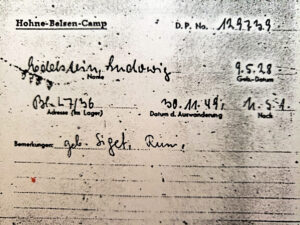
Mr. Lou's ID Card at the Belsen DP Camp.
While looking over many historical documents and photos from the Belsen DP Camp from 1945 – 1950, there are very few pictures that can be found of Mr. Lou and of his motorcycle. To date, I’m only aware of the pictures that Mr. Lou had in his possession. Looking through some historical pictures from the Bergen Belsen Historical Museum in Germany which I visited, the only photos I could find were of a private motorcycle owned by a resident, and while there could have been more pictures, looking through several historical documents at the museum and the various books that have been published by survivors and organizations after the War, I have been unable to find any other motorcycle pictures. Additionally, I have not yet been able to find any individual nor group photos of Mr. Lou in the many pictures that were published in various history books and museum displays, although I have seen a copy of his Belsen Resident Card at the museum. The only pictures I’ve found of his friend Monyok Moshe Hochman, were provided by his grandson Hadar in Australia.This curiosity I believe was later explained to me by Mr. Lou’s sister in law Moncie, who was also a survivor from Sighet and married Mr. Lou’s brother Bernard. They married in Sighet after the War, and moved to Israel and then Canada. According to Moncie, Mr. Lou was very careful and modest about his position at the Camp, even though he drove the the highly visible and well known motorcycle. If not for the surviving pictures in his possession, there would be very little historical data available about Mr. Lou and his role at the Camp. I’ve also noticed that not all of the policemen at the Camp had their photos on file at the Bergen Belsen museum nor in history books, although there may be some floating around in private collections from former Belsen residents and their descendants throughout the world.
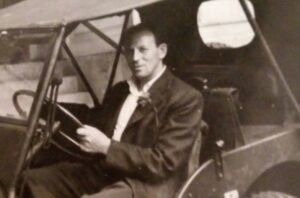
Monyok Moshe Hochman in the Camp's Jeep.
As time and life went on in the Belsen DP Camp, most of the Jewish residents were moving to Israel. In March, 1949, there were about 4,500 residents living at Belsen and the British decided to close the Camp by 1950. The Jewish Agency gave the remaining Jews at Belsen options for moving on. Most of the remaining Camp residents went to Israel, and many moved to the United States or Canada. Jobs were offered for those who came to America, and the option to choose which city was available. Mr. Lou chose St. Louis, Missouri as the place he wanted to move to. He said that the reason he chose St. Louis was because he saw a magazine in the Camp that had a picture of St. Louis on the cover and he read a story about the City. It had many factories and job opportunities and he figured it would be a good place to start his new life. To his surprise, a few of his friends, without discussing it with him, came to the same conclusion. Fortunately, the Jewish Agency had many jobs available in St. Louis.
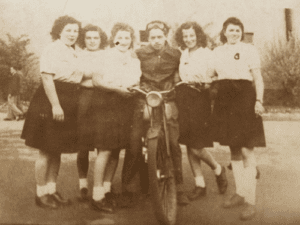
Mr. Lou with the Camp's second smaller motorcycle before it was damaged beyond repair by an Army Ammo truck. Who says women are not attracted to a man on a smaller motorcycle?
As the Camp was about to close, and the remaining residents were moving on to various locations throughout the world, Mr. Lou and several of his friends went to the port and boarded the former transport troop ship, the SS General Hershey which was sailing to the United States. On the ship, he made some new additional friends, some also bound for St. Louis, and they took the long boat trip to New Orleans, Louisiana. Once they landed, Mr. Lou and his friends took a train to St. Louis. That small group, along with some additional Survivors that he met in St. Louis after he arrived, all became lifelong friends. When Mr. Lou left Germany and boarded that ship for his new life in America, along with all his incredible life experiences, he was only 24 years old.
Shortly after settling in St. Louis, Mr. Lou met the love of his life, Regina Hochman, which by sheer coincidence, was the cousin of his old friend and motorcycle side kick, Moshe Monyok Hochman, who when he left Bergen Belsen, had migrated to Israel. Mr. Lou and Regina were both Holocaust Survivors, although Regina, her brother Wolf, and parents Arnold and Eva had British Passports while living in Germany. As British citizens living under Nazi occupied Europe, they went through various Prisoner of War Camps in Germany including the famous camp in Vittel, France, and were eventually exchanged for German civilians living in South Africa and returned to England in August of 1944, traveling through the port of Lisbon in Portugal. After knowing each other for more than a year, Mr. Lou and Regina were married until his wife, Regina passed away in 2005.
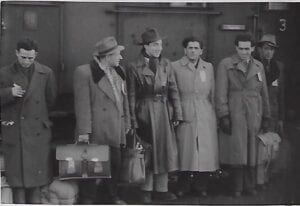
Getting ready to board the SS General Hershey for America. Mr. Lou is standing second from the right.
When he immigrated to St. Louis, Mr. Lou had a job but wanted to serve his new country and join the US Army to fight in Korea, however medically, he had flat feet which in the 1950's, made you ineligible to serve. When he went for his physical, the doctor rejected Mr. Lou yet the recruiting officer who wanted him got into an argument with the doctor. The doctor asked the officer why he wanted Mr. Lou so badly, to which the officer explained, Mr. Lou was a Holocaust Survivor and one of those rare people who could go three days without food, which in the opinion of the officer, would make him the perfect soldier. The argument didn't hold and Mr. Lou was rejected by Uncle Sam and the Army. As was the case for many Jewish Europeans before World War Two, Mr. Lou had never personally seen an African-American Black person until after he was liberated. In 1960, he bought a grocery store which was initially located in a White Jewish neighborhood but shortly afterwards, as the Jews moved closer towards the Suburbs, the neighborhood became a poor Black neighborhood, labeled a Black American ghetto in St. Louis. Mr. Lou remembered the appreciation he had for his liberation, along with the man who announced to the emaciated and barely alive prisoners that they were free and he refused to move his store and leave the neighborhood. He continued operating his grocery store in the building he acquired until the City of St. Louis forced him out by destroying the building for an “Urban Renewal” project. His customers loved and trusted him, and he was known throughout the area as someone who never cheated his customers. Everyone in the neighborhood referred to him as Mr. Lou, and the name stuck.
Mr. Lou returned to Germany and visited Frankfort in 1994 and once more in 2003 for a program held by the City of Leipzig for former residents and their descendants. His wife Regina grew up in Leipzig and was invited by the city to attend the program which hosted that year about 30 former residents. Mr. Lou and Regina were speaking to a high school group when one of the students asked him how was he able to survive all his experiences? Mr. Lou responded “I was young like you.”
Mr. Lou was always grateful for his life in America. He was disappointed to have not been able to serve in the US Military, as did some of his Survivor friends who at that time, did not all have a great command of the English language. Furthermore, not all returned alive. Mr. Lou had no regrets about coming to the United States, and he truly loved being an American and making a contribution to American society. However, he did have one regret….he regretted that after he left the Bergen Belsen DP Camp, he did not take his much loved friend, his BMW R-75 motorcycle with him to the United States. He believed that he had an option to do so, but for some reason he wasn’t sure why he left the motorcycle behind. Once in America, Mr. Lou went from driving the motorcycles he loved to driving other vehicles. Although he would never own another motorcycle while in America (I believe his wife Regina might have had something to do with that decision), Mr. Lou always remained a motorcycle fan and was always proud of the service he provided at the Belsen DP Camp as a Jewish Civil Policeman, and his role at the camp motor-pool. He was especially proud and felt fortunate to have been able to drive his BMW R-75 motorcycle.
A Postscript - The Last Meeting of a Fellow Policeman from the Bergen Belsen Camp
Many years later, in 2002, Mr. Lou took a trip to Atlanta, GA to visit one of his sons. During his trip, while attending Services at one of the local synagogues, he engaged a fellow Holocaust Survivor in conversation. The man he met, Zelman was from Vilna, Poland (In October 1939, the Soviet Union transferred the Vilna region back to Lithuania which the Poles annexed in 1922, and today, Vilna is the capital of Lithuania). Zelman went to Bergen Belsen after the War to find his brother, just as Mr. Lou (and thousands of others seeking their relatives) looked for his two sisters. Mr. Lou and Zelman arrived at Belsen at different times, but not far apart from each other. Both eventually joined the Bergen Belsen Jewish Civil Police in 1946, and even though they both were part of this small group of 125 Policemen, they did not formally meet and know each other until they met by chance in Atlanta in 2002.
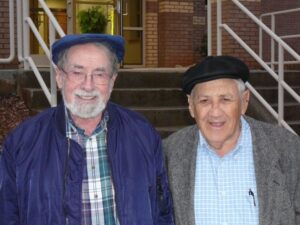
Mr. Lou with his friend Zelman in Atlanta in 2002.
During one of their discussions, Mr. Lou mentioned that he drove the Camp’s motorcycle. Zelman looked at him with a surprised look and said, “That was you?” Mr. Lou had a look of pride on his face and answered, “That was me!” With every subsequent visit to Atlanta, Mr. Lou made sure to spend some time with his new found friend Zelman as they shared memories and had a bond that only Survivors can know. Mr. Lou's friend Zelman passed away on December 4, 2014. The generation of the Holocaust Survivors, as well as the greatest generation of those who liberated them, were passing into history.
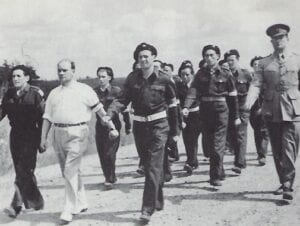
Zelman is on the left of the photo marching in formation next to the chief of police Simcha Vinick and "The Captain", David Kalnitsky who is at the extreme right.
It would be another three and a half years until the sad ending of the life of our friend, Mr. Lou. He had lost the love of his life, his wife Regina, who passed away in 2005, 13 years earlier. Mr. Lou passed away in St. Louis on June 26, 2018 at the age of 93. At the time of his passing, he left behind two sons, five grandchildren and five great grandchildren. The last member of Mr. Lou's close circle of Holocaust Survivor friends, David O, who came to St. Louis after the War, passed away in March of 2019. It was the passing of a close knit group of Survivors who shared so much together.
We were very fortunate to have been able to know Mr. Lou and tell a small slice of his story and about his happy times with his BMW R-75 motorcycle.
References and Additional Sources
There are many historical sources available for further reading. Some of the sources that were used to research this article includes, but was not limited to:
Holocaust and Rebirth: Bergen Belsen 1945 – 1965. World Federation of Bergen-Belsen Associations, New York – Tel Aviv. Edited by Sam E. Bloch
Jewish Displaced Persons in Camp Bergen Belsen 1945 – 1950; The Unique Photo Album of Zippy Orlin. Edited by Erik Somers and Rene Kok. University of Washington Press, Seattle, WA (www.washington.edu/uwpress)
New Beginnings; Holocaust Survivors in Bergen-Belsen and the British Zone in Germany, 1945 – 1950. Hagit Lavsky. Copyright 2002 Wayne State University Press, Detroit, MI.
Bergen-Belsen; Wehrmacht POW Camp, 1940-1945; Concentration Camp, 1943-1945; Displaced Persons Camp, 1945-1950. (The Catalog accompanying the permanent exhibition of the Bergen-Belsen Camp and Research Center) Lower Saxony Memorials Foundation, Germany
Atlas of the Holocaust. Martin Gilbert (1982) Pergamon Press. This book has been revised and worth having in your library. Additional Holocaust books from Sir Martin Gilbert can be found by going to: https://www.martingilbert.com/collection/holocaust/
Night. Eli Wiesel (1982) Bantam Books
Life after Belsen. Simon Bloomberg (2017) published by Al Gibson, copyright Eva Bloomberg Spiers.
The Refugee Problem of Germany. Chauncy Harris and Gabriele Wuler, Economic Geography, Vol. 29, No. 1, January, 1953
Fear: Anti-Semitism in Poland After Auschwitz. Jan T. Gross (2006) Random House Press
Additional Sources –
US Holocaust Memorial Museum
https://encyclopedia.ushmm.org/content/en/article/bergen-belsen-displaced-persons-camp
https://encyclopedia.ushmm.org/content/en/article/the-harrison-report
The Bergen Belsen Internet Museum Web Sources –
https://bergen-belsen.stiftung-ng.de/en/
https://bergen-belsen.stiftung-ng.de/en/history/
https://www.jewishvirtuallibrary.org/bergen-belsen-visitor-information

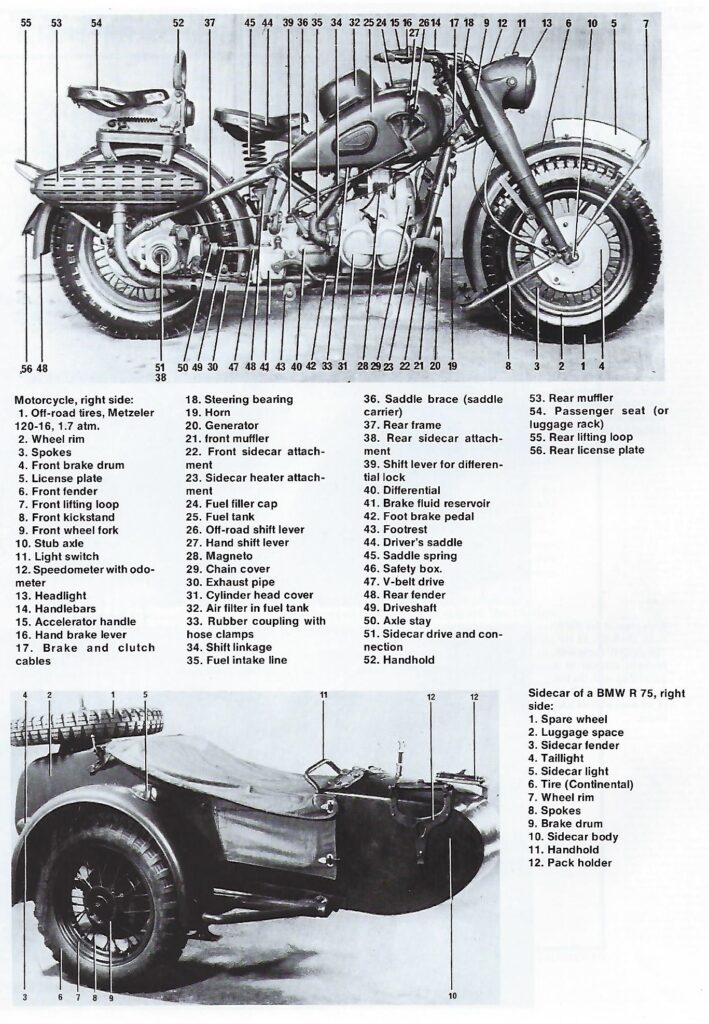
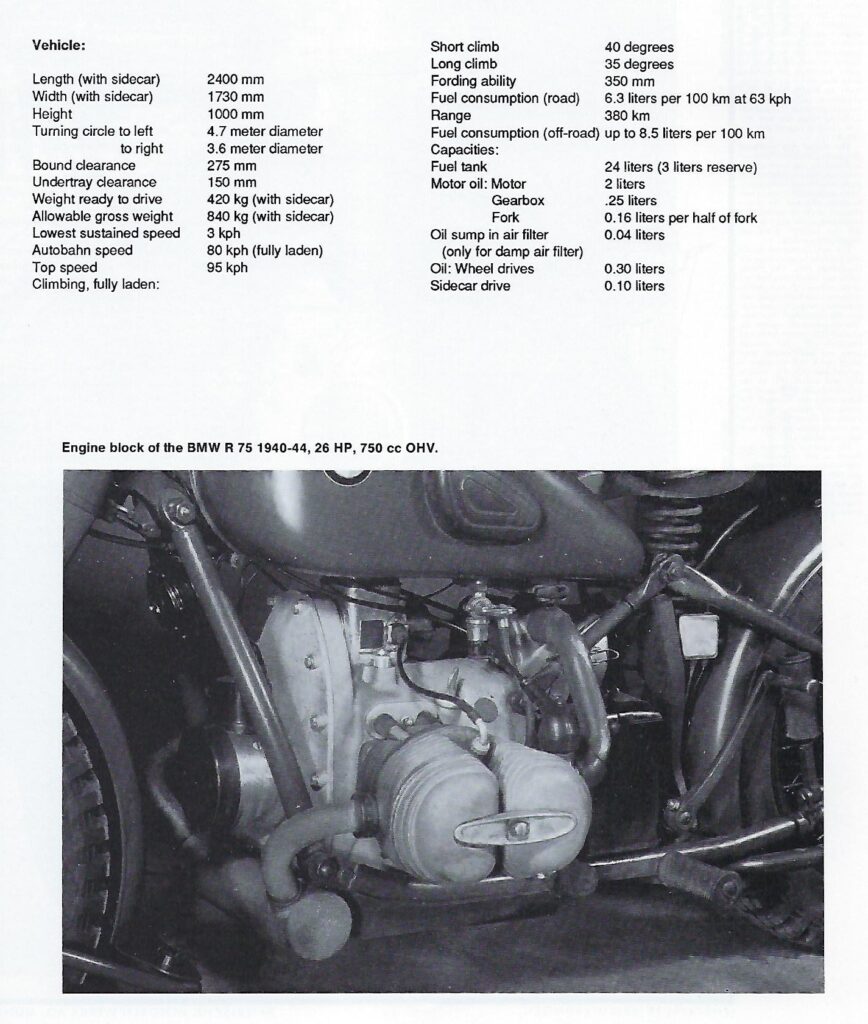
Technical Data reproduced from the book BMW Motorcycles in World War II R12/R75 by Janusz Piekalkiewicz with permission from Jürgen Steinhäuser and the publisher, Paul Pietsch Verlage GmbH & Co. KG (www.paul-pietsch-verlage.de; www.motorbuch-versand.de; www.schrauberzeit.de)